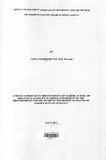| dc.contributor.author | Kimunye, Janet N | |
| dc.date.accessioned | 2013-02-28T11:32:32Z | |
| dc.date.issued | 2011 | |
| dc.identifier.citation | Master of Science in Plant Ecology | en |
| dc.identifier.uri | http://erepository.uonbi.ac.ke:8080/xmlui/handle/123456789/12348 | |
| dc.description.abstract | Weeds interfere with cotton production by competing for important resources
including light and nutrients. Several approaches are taken to control weeds in order to
achieve maximum yields. Where genetically modified cotton exhibiting resistance to
Roundup'" have been commercialised, Roundup'" has been extensively used In
controlling weeds. There, are however, reports of weeds developing resistance to
Roundup ® and interference with weed diversity where Roundup ® has been used for
long periods. In this study we tried to mimic a glyphosate tolerant field by covering
convectional cotton variety Hart 89M with polythene papers to protect cotton plants
from herbicide effect during spraying. The objective of this study was to investigate
the effect of glyphosate on weed diversity and abundance, the presence of glyphosate
tolerant species and effect of weeds on growth of cotton. This study was important
because the country is embarking on reviving the cotton industry by use of modern
technology like Bt (Bacillus thuringiensis) cotton and Herbicide resistant cultivars that
would reduce the amount of labour for weed control. Information on effect of
Roundup'" on weed diversity is not available in Kenya so this study will help In
determining if it is feasible to popularise the use of herbicides particularly Roundup'f
for weed control. Weed diversity was sampled using three 0.5 x 0.5m quadrats before
and after treatments in each subplot. The treatments included in this study were
Roundup'" spray (21/ha), hand weeding untreated check and natural vegetation. The
experimental design was a split plot design with the treatments as the main plots and
the timing of treatment as the subplots.
The R-program was used for data analysis and diversity was analysed using the Renyi
diversity index. A total of 43 weed species was recorded before spraying but this
reduced to 30 species after spraying. The most abundant species were Euphorbia
geniculata, Spermacoce laevis, Digitaria velutina and Bidens pilosa while the others
were trace. The diversity and abundance of weeds decreased significantly after
spraying with Roundup'[ 9 weeks after germination. The results obtained show that
Roundup'f is effective in controlling most of the weeds in Mwea where only
Commelina benghalensis exhibited tolerance 21days after spraying. Early hand
weeding and spraying with Roundup'[ reduced weed density which in turn resulted in
taller cotton plants (108.14±O.687 and 104.39±O.950cm), more squares (8.19 and 6.43
per plant) and higher productive bolls at (8.26 and 6.13 per plant).
From this study it is evident that early weed removal is necessary if a farmer is to
realize maximum yields. Spraying with Roundup'f reduced the diversity and
abundance of most weeds but the time of herbicide application is also important | en |
| dc.description.sponsorship | University of Nairobi | en |
| dc.language.iso | en | en |
| dc.publisher | University of Nairobi | en |
| dc.title | Effect of roundup® (glyphosate) on diversity and abundance of weeds in cotton fields in Mwea, Kenya | en |
| dc.type | Thesis | en |
| local.publisher | School of Biological Sciences | en |

